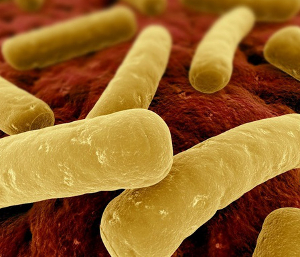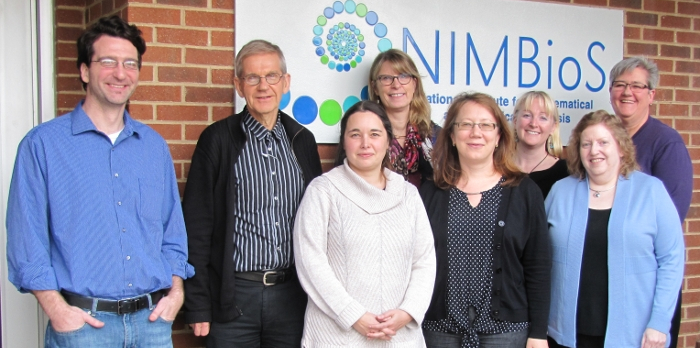| Description | Participants | Summaries | Products |
|---|
Archived NIMBioS Working Group
Modeling Antimicrobial Resistance (AMR) Intervention

Topic: Evaluating the association between shifts in antimicrobial use practices and antimicrobial resistance resulting from FDA's risk mitigation strategy
Meeting dates: September 19-22, 2014; February 23-25, 2015; March 7-9, 2016
Organizers:
Craig A. Lewis, Food and Drug Administration Center for Veterinary Medicine, Rockville, MD;
Yrjö T. Gröhn, Cornell Univ. College of Veterinary Medicine, Ithaca NY;
Objectives. The wide use of antimicrobial drugs in human and veterinary medicine has brought tremendous benefits to both humans and animals; advances that are increasingly threatened by the development of antimicrobial resistance. While antimicrobial resistance can be naturally-occurring (innate), there is general acceptance that antimicrobial use (including human, animal, and other uses) is a major contributor to acquired resistance. Therefore, it is critical that antimicrobial products are used responsibly to preserve their effectiveness. FDA is preparing to implement new risk mitigation strategies to promote judicious use of medically-important antimicrobials in food-producing animals. An interagency group (involving FDA, USDA and CDC) has been charged with identifying information that can be collected to monitor associations between shifts in antimicrobial use practices and resistance patterns. However, the connection between antimicrobial use and resistance is complex and a suitable mathematical framework to analyze this relationship is currently unavailable. This NIMBioS Working Group will identify specific analytical methods and quantitative data that are appropriate for associating population-level changes in antimicrobial use in livestock with population-level changes in antimicrobial resistance. This is a unique opportunity to use a systems approach to inform monitoring and assessment of an imminent intervention. The group's work will identify strategic methods for data collection, analysis and synthesis to address research and regulatory questions and to allocate limited resources efficiently.

Meeting Summaries
| Mtg # | Dates | Agenda | Summary | Photo | Evaluation |
|---|---|---|---|---|---|
| 1 | Sep 19-22, 2014 | Link | Link | Report | |
| 2 | Feb 23-25, 2015 | Link | |||
| 3 | Mar 7-9, 2016 | Link | Link |
Meeting 1 Summary. During the first meeting, the Modeling Antimicrobial Resistance Intervention Working Group reviewed the risk pathways associated with antimicrobial use in food-producing animals and antimicrobial resistance; reviewed current and possible future monitoring systems; discussed relevant modeling and statistics approaches; and reviewed validation/verification processes. The group reevaluated the overall objective of this working group (to develop a systems approach to identify specific conceptual approaches, analytical methods, and quantitative data sources that are appropriate for associating population-level changes in antimicrobial use in livestock with population-level changes in antimicrobial resistance), with a particular focus on assessing the impacts of FDA's Guidance for Industry #213. The group summarized available and needed data, and outlined a draft framework consisting of three distinct components. The participants will work on developing these individual components in the coming months and discuss progress regularly during monthly meetings. The second working group meeting is targeted for spring 2015.
Meeting 2 Summary. During the second meeting, the Modeling Antimicrobial Resistance Intervention Working Group reviewed the scope of the project and the status of the component modeling methods currently under development; discussed data sets and special topics related to the group's work; developed a conceptual map of how the project and component modeling methods relate to the overall system. The group discussed the expected outcome of this working group as represented in the President's National Strategy to Combat Antibiotic Resistance Bacteria ("develop an analytic modeling framework for assessing the relationship between antibiotic use in livestock (measured at the population level) and the development of antibiotic resistance"; page 18). The group identified data needs, developmental next steps and areas of integration between the individual modeling methods, including overall project planning as well as setting milestones to be reached prior to the next meeting. The participants will continue to work on developing these individual components in the coming months and discuss progress regularly during monthly meetings. The third working group meeting is targeted for summer or fall 2015.
Meeting 3 Summary. During the third meeting, the Modeling Antimicrobial Resistance Intervention Working Group evaluated the overview of the first completed draft report entitled, "A proposed analytic framework for determining the impact of an antimicrobial resistance intervention at the national level." The group identified main areas of needed work, began more detailed work on specific areas within sections and re-evaluated the draft worked during the first two days of the meeting. On the third day, the group developed a plan to complete the report by the end of the summer. Lead and co-writers for each section of the document were appointed and monthly conference calls (April 11, May 13, June 21 and July 15) were agreed upon. A shorter article based on the full document is targeted for late summer or fall 2016 completion. The article will point the reader to the full document that will be hosted on the NIMBioS Working Group web page under the "Group Products" tab.
 |
| Mtg. 1 participants: (Back, L to R) Kathe Bjork, Thomas Van Boeckel, Yrjo Grohn, Laura Pullum, Laura Hungerford, Ian Spicknall; (Front, L to R) Beth Karp, Victoriya Volkova, Min Li, Cristina Lanzas, Jose M. Ponciano, David White; (Not Pictured) Craig Lewis, Carolee Carson. |
 |
| Meeting 3 participants (L to R): Craig Lewis, Yrjo Grohn, Cristina Lanzas, Kathe Bjork, Victoriya Volkova, Carolee Carson, Beth Karp, Laura Pullum. |
NIMBioS Working Groups are chosen to focus on major scientific questions at the interface between biology and mathematics. NIMBioS is particularly interested in questions that integrate diverse fields, require synthesis at multiple scales, and/or make use of or require development of new mathematical/computational approaches. NIMBioS Working Groups are relatively small (up to 10 participants), focus on a well-defined topic, and have well-defined goals and metrics of success. Working Groups will meet up to 3 times over a two-year period, with each meeting lasting up to 2.5 days.
A goal of NIMBioS is to enhance the cadre of researchers capable of interdisciplinary efforts across mathematics and biology. As part of this goal, NIMBioS is committed to promoting diversity in all its activities. Diversity is considered in all its aspects, social and scientific, including gender, ethnicity, scientific field, career stage, geography and type of home institution. Questions regarding diversity issues should be directed to diversity@nimbios.org. You can read more about our Diversity Plan on our NIMBioS Policies web page. The NIMBioS building is fully handicapped accessible.
NIMBioS
1122 Volunteer Blvd., Suite 106
University of Tennessee
Knoxville,
TN 37996-3410
PH: (865) 974-9334
FAX: (865) 974-9461
Contact NIMBioS


